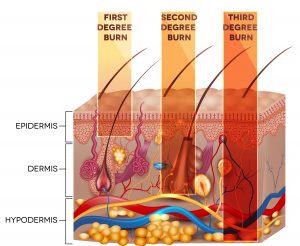
Skin burn classification. First, second and third-degree skin burns. Detailed skin anatomy.
Burn symptoms vary depending on how deep the skin damage is. It can take a day or two for the signs and symptoms of a severe burn to develop.
1st-degree burn. This minor burn affects only the outer layer of the skin (epidermis). It may cause redness and pain.
2nd-degree burn. This type of burn affects both the epidermis and the second layer of skin (dermis). It may cause swelling and red, white, or splotchy skin. Blisters may develop, and pain can be severe. Deep second-degree burns can cause scarring.
3rd-degree burn. This burn reaches the fat layer beneath the skin. Burned areas may be black, brown, or white, and the skin may look leathery. Third-degree burns can destroy nerves, causing numbness.
Treatment
Most minor burns can be treated at home. They usually heal within a couple of weeks.
Medical Treatment
Water-based treatments. Techniques such as ultrasound mist therapy clean and stimulate the wound tissue.
Fluids to prevent dehydration: You may need intravenous (IV) fluids to prevent dehydration and organ failure.
Pain and anxiety medications-Healing burns can be excruciating. You may need morphine and anti-anxiety medications — particularly for dressing changes.
Burn creams and ointments- May select from various topical products for wound healing, such as bacitracin and silver sulfadiazine (Silvadene). This helps prevent infection and prepares the wound to close.
Dressings-Various specialty wound dressings to prepare the wound to heal. If you are being transferred to a burn center, your wound will likely be covered in dry gauze only.
Drugs that fight infection: If you develop an infection, you may need IV antibiotics.
Tetanus shot. Your doctor might recommend a tetanus shot after a burn injury.
0 Comments